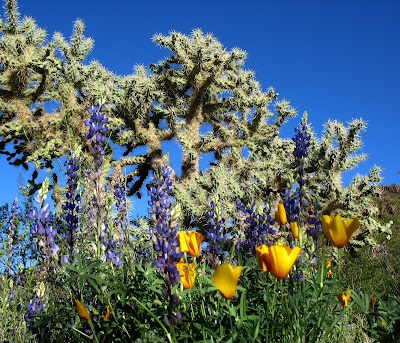if I fiddle with them just right...extreme close-ups can be fun...


 ...I've never had a tomatillo plant before; my mother said that she remembers, as a child, having these in Korea as ornamental plants--nice flowers; they didn't realize that the tomatillos were edible!
...I've never had a tomatillo plant before; my mother said that she remembers, as a child, having these in Korea as ornamental plants--nice flowers; they didn't realize that the tomatillos were edible!






 ...by mid-day, the desert is shimmering with color...
...by mid-day, the desert is shimmering with color... ...one section along Picture Rocks Road still has a carpet of Mexican gold poppies and lupine under the cholla...
...one section along Picture Rocks Road still has a carpet of Mexican gold poppies and lupine under the cholla... ...and these are desert chicory blooms...
...and these are desert chicory blooms... ...some fiddleneck staring at you...
...some fiddleneck staring at you......and some desert hibiscus...

(incidentally, globemallow was used by native SW tribes as a poultice for wounds and also as a diarrhea remedy... )
===============
Last week I drove down to Sierra Vista, where I lived as a kid...
Just four miles from my old house is the San Pedro River riparian reserve--it wasn't accessible to the public back when I lived there, but now it is a nature reserve--a corridor of cottonwood forest along one of the few remaining flowing desert rivers; it is one of the most important migratory-bird-routes in North America.
The high grasslands (four to five-thousand feet above sea-level) are still brown; spring is just barely arriving in this area, compared with Tucson, which is two to three thousand feet lower in elevation. The Huachuca mountains still have a lot of snow on their northern slopes...

The cottonwoods are just beginning to get a tinge of green above the river. (It's more of a 'stream' really, but in the desert, this qualifies as a river, since it flows year-round.) Until a couple of decades ago, jaguars would occasionally be spotted in this area, visiting from their more traditional habitat in Mexico! In the nearby Chiricahua mountains, there used to be a native species of thick-billed parrot...SE Arizona is truly an environmental crossroads...
...a great blue heron:
...and a red-tailed hawk...
...I've not yet looked up what this yellow-bird is:
======================================
...and that's it for this posting; a few of my points-of-view.








No comments:
Post a Comment